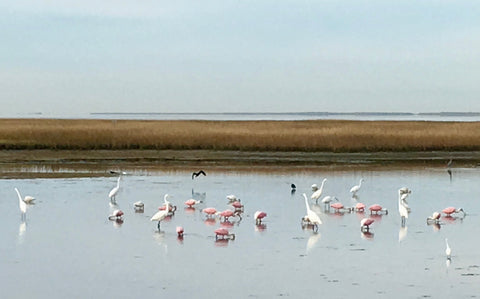The 118th Christmas Bird Count
For over a century, citizens around the globe have participated in the annual Audubon Christmas Bird Count. Every year for 118 years, volunteers gather in parks, prairies, woodlands, waterfronts, and in their own backyards dedicated to citizen science and bird conservation. The 2017-2018 Christmas Bird Count (CBC) started on December 14 and ends soon on January 5, 2018. There is still time to get outside and observe even if for your own viewing pleasure. To learn more about the participating areas throughout the Americas for this year or next, visit http://www.audubon.org/conservation/join-christmas-bird-count

Last year, I participated in the 117th CBC with Houston Parks and Recreation. This photo is from Glenwood Cemetery where we made quite a few exciting observations, a downy woodpecker, a pine warbler, a group of tiny Carolina wrens, as well as, a couple of American black crows cawing throughout the graveyard. Many famous Texans are buried here including Howard Hughes and actress Gene Tierney.
Originally, the Christmas bird count was a hunt with tallies including the number of species shot. In 1900, scientist and conservationists noticed a decline in bird populations. Ornithologist, Frank M Chapman for the incipient Audubon Society, proposed the first Christmas Bird Census. 27 participants in 25 locals gathered data throughout Canada and the United States reporting 90 species. Currently in the 118th count, 390 areas from Baffin Island near the North Pole to the tip of Argentina have reported over 800,000 birds.*

Cranes, Egrets, Herons, Cormorants and Rosette Spoonbills fishing during low tide. Welcome to Galveston Island.
Cody and I spent several mornings investigating the marshy areas of Galveston Island including Sweetwater Preserve and Jamaica Beach along the bay. The weather was grey, cold, and cloudy for days and weeks. However, this is a great time to view the birds as they gather together in the marsh to keep warm.

Not always easy to spot as this group of Yellow Crowned Night Herons take shelter.

Tricolored Heron, photo by Cody Jones

My favorite, the Rosette Spoonbill in flight. Photo by Cody Jones
Galveston Island is a barrier island along the Upper Texas Coast and a major flyway for migrating birds from Alaska to South America. The island is over 32 miles with beaches, ponds, marsh, wetlands, tall grass prairie, dunes, bay and gulf waters. Many birds live here year round but most pass through on their biannual migrations. In fact, Galveston is one of the top locations for birding in the country.

Sandhill Cranes are migratory visitors to the island. The causeway bridge to Galveston Island is featured in the background. Photo by Cody Jones

Sandhill Cranes overwinter in groups of 3, a mated pair and an offspring. The 2 at the bottom broke off and the third followed.

During our 3 day observation we counted 21 or 7 groups of Sandhill Cranes, an Osprey, Starlings, Great Tailed Grackles, Snowy Egrets, Great Egrets, Terns, Pipers, Plovers, Brown & White Pelicans, Spoonbills, Cormorants, Anhingas, Herons of all types, Hawks, White Ibis, Swallows, and a Reddish Egret. We heard many calls that we were unable to identify. Experienced birders can identify by sound even if the species is not seen. We enjoyed getting outside on some seriously cold, wet days. This is our 118th Christmas Bird Count record of species.
One last photo for fun. (It was so cold the horse had a blanket.) Photo by Cody Jones

To learn more about the Sandhill Cranes read The Botanical Journey Article by clicking here.
To learn about the Migratory Bird Act read our article by clicking here
Reference for the above CBC data:
*National Audubon Society (2010). The Christmas Bird Count Historical Results [Online]. Available http://www.christmasbirdcount.org January 3,2018.

Leave a comment
Please note, comments must be approved before they are published